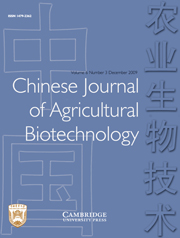Article contents
Screening, cloning and sequence analysis of gBTN1A1 gene in mammary gland of Xinong Saanen goat
Published online by Cambridge University Press: 27 June 2008
Abstract
Butyrophilin 1A1 (BTN1A1), which is a member of the Ig superfamily, is highly expressed in the lactating mammary gland and is secreted into milk in association with lipid droplets, and concentrated in the apical plasma membranes of mammary epithelial cells. Because butyrophilin is expressed only during lactation, it appears to be essential for milk fat globule production. However, there is little information about its properties in the dairy goat. The objective of this study was to confirm whether butyrophilin was related to milk changes in different lactation periods of Xinong Saanen goats. Using suppression subtractive hybridization analysis, we identified a significant increase in butyrophilin mRNA in Xinong Saanen goat mammary gland at middle lactation when compared to that of late lactation. The gBTN1A1 complementary DNA has an open reading frame of 1581 nucleotides encoding a putative protein of 526 amino acids. Amino acids 1–26 were the signal peptide domain. The homologies of nucleotide and peptide sequences of goat butyrophilin with bovine (NM_174508), human (NM_001732) and mouse (AK145168) butyrophilin were 97 and 96%, 88 and 84%, 84 and 70%, respectively. The secondary structure, transmembrane domain and hydrophilicity of goat butyrophilin were similar to the those of the bovine, human and mouse protein. In conclusion, we confirmed that the goat mammary gland mRNA level of gBTN1A1 was responsible for goat milk fat globule secretion.
Keywords
Information
- Type
- Research Papers
- Information
- Copyright
- Copyright © China Agricultural University 2008
Footnotes
First published in Journal of Agricultural Biotechnology 2007, 15(5): 772–777
References
- 1
- Cited by

